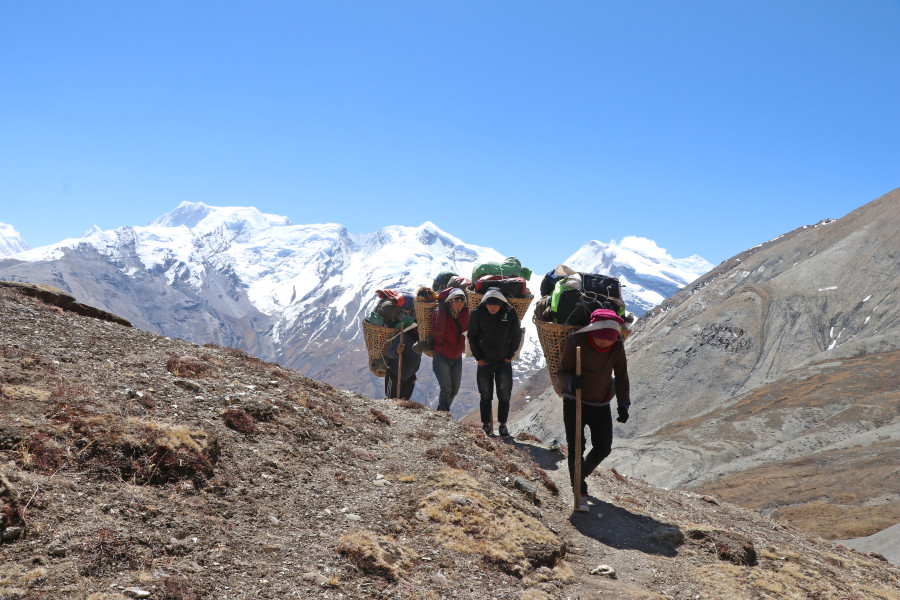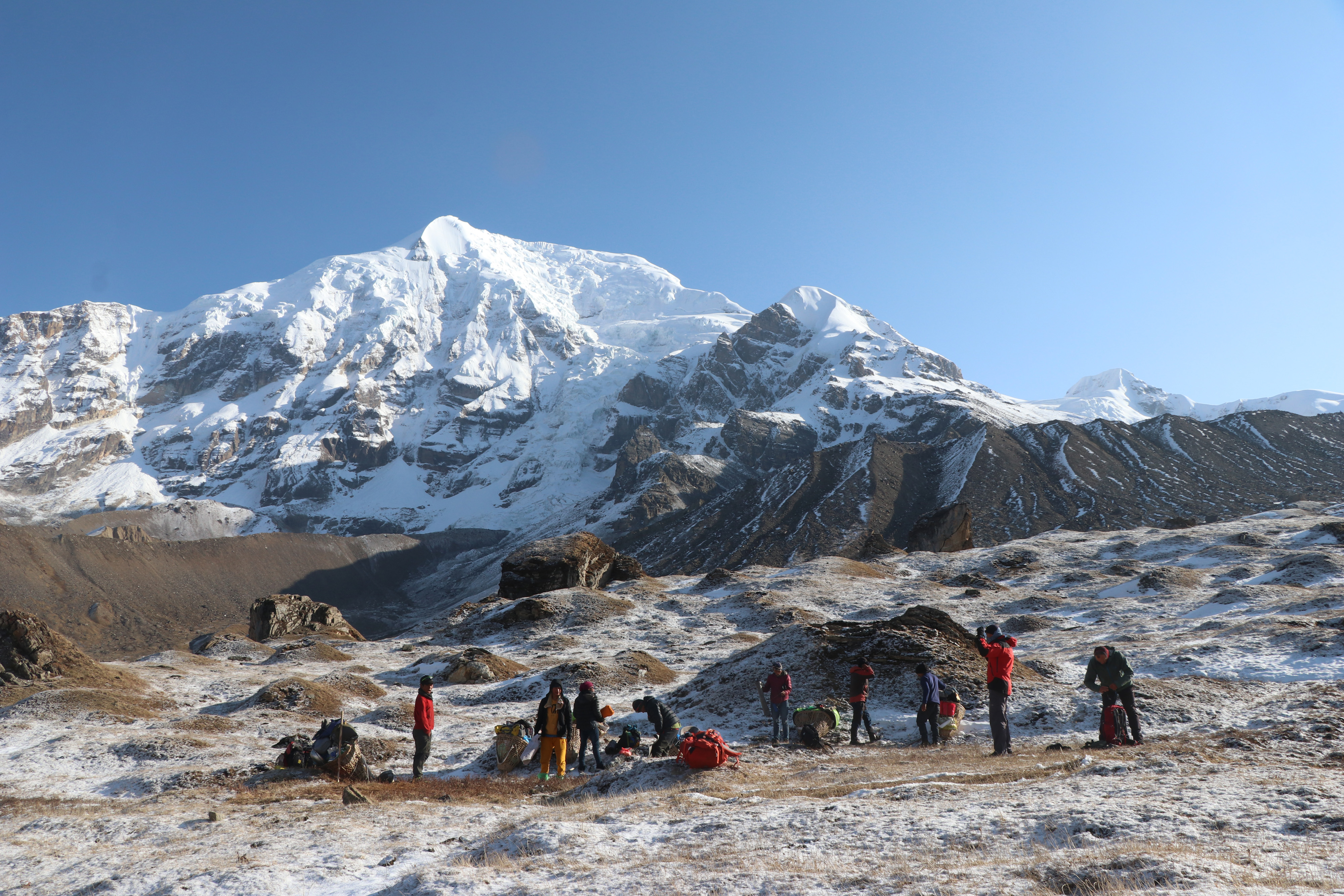Money
Putting adventure back in trekking in Annapurna
Guides are exploring alternative routes untouched by modernity after the old trails became highways.
Deepak Pariyar
Shesh Kanta Sharma spent his youth as a trekking guide, taking guests from around the world on camping treks in the foothills of Mt Annapurna.
The camping treks, mostly to places where there are teahouses, were popular among foreigners. Hordes of trekkers used to throng the Annapurna Circuit, spending more than two weeks walking up and down the narrow valleys and deep gorges.
Sharma brightens up as he recalls those days. “Camping treks were a matter of pride back then,” he said. “Those days, however, are things of the past.”
Sharma remembers the columns of Sherpa porters carrying essentials in bamboo baskets on their backs. The trekkers follow them. When they reached the day's destination, tents would be put up, and the Sherpa guides would prepare dinner.
The place looked colourful with tents scattered all over. Early in the morning, the tourists come out of their tents and sip coffee as they admire the mountains glowing in several colours as the sun comes up.
Camping treks, once a popular pastime among visitors, are losing their charm.
The scenic hiking trails can now be reached by motor vehicle. Hotels and lodges have come up on the former camping grounds, and travellers do not need to sleep in tents anymore.
As the road network extends further up the Himalayan foothills, the walking route is becoming shorter and shorter. The tourists are spending less money too.
“There were no lodges and restaurants on the trekking trails,” added Sharma. “The adventure was worth the money.”
The trek from Lamjung to Kaski via the Besisahar-Manang-Thorong La-Muktinath-Birethanti route took 21 days.
Royal Trek and Panchase Trek, the shorter trails preferred for camping around Pokhara, could be accomplished in three days. The camping trek in Ghorepani was also popular till 2003.
The tourists had to take shelter at Bhadaure on the final day of the three-day trek to Panchase, where the three districts of Kaski, Parbat and Syangja meet. Locals used to beautify the camping spot as they knew the tourists would be coming.
Local kids would gather at the place donning cultural dresses. The tourists would be fascinated by the merrymaking and activities of the residents.
“These days, we can’t get such an ambience even by spending a lot of money.”

Sharma entered the tourism industry as a porter in 1987, and joined the Tiger Mountain Group in 1991. He obtained a tourist guide licence in 1998.
The years 1998 to 2005 were the heyday of camping treks.
“We had so many groups that we barely had time even to clean our clothes from the earlier trips,” said Sharma. “Now there are just a few such treks.”
Sharma also took tourists to Dolpo and Dhaulagiri on camping treks. These areas still see camping treks. The tourists have a special interest in the region to observe Tibetan culture and the natural habitat of the snow leopard.
These days, the tourists don’t spend much time and effort on treks like before. They enjoy brief treks with stops in lodges and tea houses.
Because of the lodges, tourist stay and the amount of money they spend on treks have been reduced. According to Sharma, a three-week camping trek has been shortened to one week.
The tourists used to spend around $200 per day on a camping trek. Now, a trek that ends in a lodge costs $100 per day.
Nearly 10 porters and helpers were required to serve two tourists on a camping trek—one of the key employment generators at that time.
Lucky Karki, proprietor of Three Sisters Adventure Trekking, used to take tourists on the Mardi Trek, which was a camping trek. There were no hotels on the trail back then.
“A string of hotels and lodges have mushroomed on the trail,” said Karki. “The tourists too prefer comfortable accommodation.”
He said that trekking agencies had stopped conducting camping treks as they are expensive and logistically difficult.
“It’s not that the number of spending tourists has increased. But trekking has become cheaper due to the cut-throat competition among trekking companies,” said Karki.
Dharma Raj Panthi, president of the Trekking Agency Association of Nepal (TAAN) in Gandaki, says tourists are less interested in camping treks these days.
“The most important thing is that hiking trails should not be replaced by motorable roads,” said Panthi. “Locals should also provide firewood and water at the campsites.”

TAAN is currently working on the conservation and promotion of the walking trail to the northern base camp of Annapurna as a camping trek.
Panthi also emphasised the possibility of promoting camping treks by identifying new destinations and alternative trails.
French mountaineer Maurice Herzog climbed Annapurna for the first time in 1950. The event marked the beginning of trekking tours in Nepal.
Over the following decades, motorable roads started to snake up to high altitudes. Hotels started to pop up on the camping grounds. And camping treks gradually turned into tea house and lodge treks, so named as trekkers slept in the tea houses that dotted the trails.
According to Sharma, there were no hotels beyond Chhomrong on the route to Annapurna Base Camp. The trek from Nayapul in Pokhara to Jomsom and back took around 28-29 days.
Sharma remembers seeing the stunned expressions of the trekkers when they stepped out of their tents in the morning and confronted the mountains. The tourists cried with happiness, shouted, leapt and hugged their partners in sheer excitement.
“It makes no sense to set up a camp in the backyard of a hotel,” added Sharma. “Camping was a compulsion previously, but now it has turned into a fun thing.”
Sharma is currently engaged in a campaign to revive camping treks on alternative trails where there are no motorable roads, hotels and lodges.
He set off on an expedition from Sikles in Kaski to Thini in Mustang via Manang’s Timang in mid-August last year.
During the nine-day trek, he crossed three passes, Namun La (4,850 metres), Kang La (5,300 metres) and Mesokanto (5,300 metres). The trail would take 23 days for tourists.
Sharma also prepared a 10-day package on the Toni Hagen Trail locally known as the Gurung Heritage Trail from Sikles to Timang via Kori and Dudh Pokhari.
This trail has no hotels or lodges between Sikles and Timang, and camping is the only option.
Sharma's trekking company Mountain Legend had taken a group of 18 foreigners on a trek on the Toni Hagen Trail in October. A team of 70 Nepali workers accompanied the group to provide support. But the trekking party had to return from Sikles due to bad weather.
“Tourists these days come for a short duration, so they don’t have much interest in long treks,” said Sharma. “However, we can still create a charming trip like before if we are able to promote shorter camping treks of 8-10 days.”
Prem Rai, a guide and tourism entrepreneur, has also been making efforts to revive alternative trails and camping treks.
Rai first came to Pokhara from Sankhuwasabha nearly two and a half decades ago. He began his career in the tourism industry as a porter and later became a tourist guide.
He now runs Prem’s Nepal Trek Company. He has spent nearly 80 percent of his trekking career in the Annapurna region.
After the Annapurna trek was slashed from three weeks to one week when they built a motorable road, Rai got involved in a search for alternative trails untouched by modernity. His quest received a boost after he met Andres De Ruiter, a German trekker.
Rai had written an English article about the seven passes of Annapurna. Andres read the article, and greatly intrigued, came looking for Rai.
Andres, who has visited Nepal 42 times since 1986 for trekking, was worried about the trails being ruined by construction. The duo teamed up to explore alternative trails.
Originally, the Annapurna Circuit trek began at Besisahar, the headquarters of Lamjung. But now a motorable road goes all the way up to Tanki-Kharsang in Manang. On the Mustang side of the circuit, there is a motorable road up to Muktinath.
Rai and Andres commenced their search for alternative trails in 2011. The route from Besisahar, Lamjung to Tatopani, Myagdi intersects motorable roads only in a few places.
The trail begins in Bhulbhule at Besisahar and reaches Muktinath in Mustang via Bahundanda-Chiple-Jagat-Taal-Nache-Tilche-Tachai-Timang-Chame-Upper Pising-Ghyaru-Ngawal-Julu Tanke Phant-Bhrak-Yak Kharka Phedi-Thorang La.
From Muktinath, a three-week hike leads to Tatopani via Jhong-Puthak-Kagbeni and connects Thini-Marpha-Tukuche-Larjung.
The duo has also explored alternative trails in other areas of the Annapurna region. They have placed directions and signage on the trail. Red and white signs indicate the main route while white and blue signs indicate a secondary route on the alternative trail.
“This has been helpful on the trail,” said Rai. “I take tourists on the same route.”
According to Rai, the trail can attract high-end trekkers if it is promoted well. “It’s a perfect camping trek,” said Rai.




 10.12°C Kathmandu
10.12°C Kathmandu.jpg)














